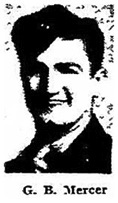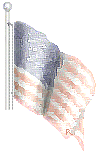G. B. Mercer Among First Up Suriabachi
Among the four marines who had the honor of being the first to reach the highest point of Mt. Suribachi, 566-foot volcanic cone on the southern tip of Iwo Jima, Friday, two hours before a patrol planted the American flag on the captured volcanic cone, was Pfc. George B. Mercer, 20, of Waterloo, nephew of Dr. and Mrs. H. L. Bagwell, 115 Johnson street.
The peak was a key point in the bitterly-contested campaign.
This was far from the first action Private Mercer has seen with the marines as he served 14 months in the southwest Pacific as a marine paratrooper participating in the battles of Bougainville and Guadalcanal.
He returned to the United States early in 1944 and was an instructor at Oceanside, Cal., for six months before returning to the Pacific with a marine raider group in the Fifth division. He has been in the marines since January, 1942, enlisting while a junior student at West high school.
The other three men with Private Mercer were Sgt. Sherman Warson, 22, Fairfield, Ia.; Pfc. Ted J. White, 21, Lyons, Kan.; and Pfc. Louis C. Charles, 18, Evaro, Mont.
They were followed by Second Lt. J. Raymond Wheelan, 24, of Belmont, Mass., a platoon leader, and Capt. Arthur H. Maylor, 24 of Port Jervis, N. Y.
The flag raising unit which arrived soon after included Staff Sgt. Lou Lowey, 23, of Pittsburgh, Pa., photographer, who smashed his camera when he dived head-long out of the way of a Japanese grenade.
A long Japanese appeared at the mouth of a cave along the crater and threw the hand grenade at the marines raising the flag. Two men held the pole while the others took care of the intruder.
Source: Waterloo Daily Courier, Waterloo, Iowa, Sunday, February 25, 1945, Section Two, Page 13 (photo included)
![]()
Mercer, Hero of Iwo Jima, Hurt
Marine Pfc. George B. Mercer, 20, who had the honor of being one of the first four marines to reach the highest pint of Mt. Suribachi on Iwo Jima, has written that he was wounded in the upper lip during combat on that island.
The letter, written Mar. 17 and received Saturday by Dr. and Mrs. H. L. Bagwell, 115 Johnson street, stated that a bullet entered his lip and lodged in his right cheek. He stated that he was now hospitalized but expected to return to his company in less than a week.
This is the first direct word Dr. and Mrs. Bagwell had received from their nephew since fighting began on Iwo. He is also a veteran of Bougainville and Guadalcanal.
Source: Waterloo Daily Courier, Waterloo, Iowa, Sunday, March 25, 1945, Page 5
![]()
FIGHTING MEN WHITESELL
AND MERCER KILLED
One on Iwo; Another on the West Front;
Six Men Are Wounded.
As Waterloo and the rest of the nation mourned its late commander-in-chief, Franklin D. Roosevelt, the impact of war was felt again in a number of homes through casualty reports of loved ones from the battlefronts.
Two were reported dead, one on Iwo Jima and one in Germany, and six wounded, all the later on the German front.
The dead:
Marine Pfc. George B. Mercer, 20, killed in action March 26, on Iwo Jima.
Pvt. Virgil Whitesell, 18, killed in action with the Ninth army in Germany, March 24.
The wounded:
Staff Sgt. Deloy L. Gabbard, on March 28.
Staff Sgt. Clarence W. Dawson, on March 29.
Sgt. Michael Zegarac, in late March.
Pfc. William S. Hayes, on March 31.
Pfc. Edward A. Schultz, on March 27.
Pfc. William J. Halterman, on April 2.
* * *
Private Mercer, 20, one of the first four men to reach the summit of Mt. Suribachi, volcanic cone on barren Iwo, was killed soon after he had returned to action after being slightly wounded in the cheek in earlier stages of the battle for the island.
Word of his death came in navy department messages to his wife, Donna Jeanne Mercer, who makes her home with her parents, Mr. and Mrs. A. H. Carlson, 821 Bayard street, and his uncle and aunt, Dr. and Mrs. H. L. Bagwell, 115 Johnson street, with whom he had made his home prior to entering the service.
His mother, Mrs. Herbert Sager, resides at Onawa, Ia. His father preceded him in death six years ago.
He was born May 8, 1924, and attended West high school in Waterloo. He was married March 10, 1944. After his enlistment as a marine paratrooper in January, 1942, he saw service on Guadalcanal, Bougainville, New Caledonia and other Pacific campaigns, before seeing action on Iwo.
On the latter island, he served as platoon leader, despite his private first class rating, for six days after all superior platoon officers had been killed.
He is also survived by two brothers, Charles R., a prisoner of war in Germany, and Robert B., in submarine service on the Pacific; a sister, Margie Ann, Onawa, [Page 11] and a half-sister, Mary Jean Sager, Onawa.
Source: Waterloo Daily Courier, Waterloo, Iowa, Sunday, April 15, 1945, Section Two, Pages 9 & 11
![]()
Lean Details of Mercer’s Heroic Death
An ironic fact about the death of Pfc. George B. Mercer, 20, formerly of Waterloo, who was among the first four men to reach the summit of Mt. Suribachi, volcanic cone on Iwo Jima, was that two hours after a Jap bullet ended his life, the 28th division in which he served, was ordered to evacuate the island, according to word received here.
The first-hand account of how Private Mercer met his death fighting has been received here by his uncle and aunt, Dr. and Mrs. H. L. Bagwell, 115 Johnson street.
The account was contained in a clipping by a war correspondent, Ray Coll, Jr., which appeared in an eastern newspaper, which has been forwarded to Dr. and Mrs. Bagwell by a buddy of their nephew.
Previously the only news that had been received here was the fact that Mercer had been killed in action Mar. 26, on Iwo Jima. He had written to his aunt and uncle here just prior to his death that a war correspondent had been talking to him. It is believed that the article in the clipping was by that same correspondent.
Referring to the fact that Mercer was a member of the 28th marines, first patrol to scale Mt. Suribachi, at least two hours before the famous flag raising episode, the article by War Correspondent Coll relates:
“In the succeeding day all members of the patrol were killed or wounded until only Mercer was left. After 23 days of action Mercer was slightly wounded by a hand grenade and after being patched up was resting ‘near the beach’ on the night the Japs made their bonzai (sic) charge 200 strong. The island had been declared secured several days previously, but remnants of the disorganized Nips got together for their final death march.
“The army air forces had just moved into Iwo and it was they who caught the brunt of the charge, but many broke through to the rear into the marines’ area.
“At one time Mercer, although only a private first class, found himself in command of a rifle platoon, ordinarily commanded by an officer and for six days led the men over impossible terrain until the end of the island was in sight.
“One evening a shell fragment creased his helmet but left him uninjured. That’s when he was sent back, but his injury was not considered serious enough to evacuate him from the island. Then came the bonzai charge. Pfc. Earl H. Clark, Jr., 22, Boulder City, Nev., and a couple of buddies were in a nearby fox hole.
“Clark saw a Jap crawling toward his foxhole. Clark was armed with only a bone-handled knife and when the Jap reached the lip of he foxhole, he jumped out on him, rolled him over and plunged the knife into his neck.
“‘He was sure slow dying,’ Clark said. Meanwhile the Japs kept coming. It was then that Clark saw Mercer rise up from his foxhole, armed only with a pistol and began shooting it out toward the Japs. But he was outnumbered and the Japs got him.”
Source: Waterloo Daily Courier, Waterloo, Iowa, Sunday, August 12, 1945, Page 5
![]()
Service News
Mr. and Mrs. A. H. Carbon, 821 Bayard street, have received word from their daughter, Mrs. Donna Jeanne Mercer, Dayton, O., that she has received the Purple Heart and Gold Star, awarded posthumously to her husband, Marine Pfc. George B. Mercer.
Private Mercer was wounded on Iwo Jima Mar. 13 and Mar. 26 and died instantly from the last wounds. Mrs. Mercer is employed by the war department as a typist in the material center, Wright field, O.
Source: Waterloo Daily Courier, Waterloo, Iowa, Sunday, August 26, 1945, Page 7
![]()
Pvt. George B. Mercer was initially buried in the 5th Marine Division Cemetery, Iwo Jima and in March 1949 was permanently buried in the National Memorial Cemetery of the Pacific, Honolulu, Hawaii.
Source: ancestry.com
![]()

